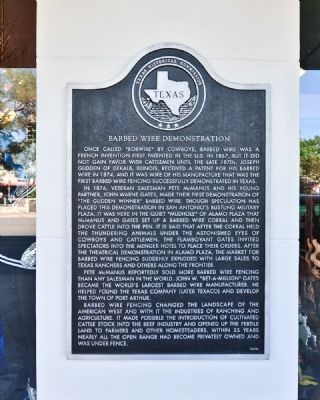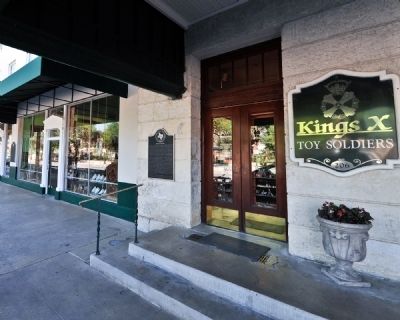Alamo Plaza in San Antonio in Bexar County, Texas — The American South (West South Central)
Barbed Wire Demonstration
In 1876, veteran salesman Pete McManus and his young partner, John Warne Gates, made their first demonstration in San Antonio's bustling Military Plaza, it was here in the quiet "mudhole" of Alamo Plaza that McManus and Gates set up a barbed wire corral and then drove cattle into the pen. It is said that after the corral held the thundering animals under the astonished eyes of cowboys and cattlemen, the flamboyant Gates invited spectators in the Menger Hotel to place their orders. After the theatrical demonstration in Alamo Plaza, the market for barbed wire fencing suddenly exploded with large sales to Texas ranchers and others along the frontier.
Pete McManus reportedly sold more barbed wire fencing than any salesman in the world. John W. "Bet-A-Million" Gates became the world's largest barbed wire manufacturer. He helped found the Texas Company (later Texaco) and develop the town of Port Arthur.
Barbed wire fencing changed the landscape of the American west and with it the industries of ranching and agriculture. It made possible the introduction of cultivated cattle stock into the beef industry and opened up the fertile land to farmers and other homesteaders. Within 25 years nearly all the open range had become privately owned and under fence.
Erected 2000 by Texas Historical Commission. (Marker Number 11742.)
Topics. This historical marker is listed in these topic lists: Industry & Commerce • Settlements & Settlers. A significant historical year for this entry is 1867.
Location. 29° 25.483′ N, 98° 29.2′ W. Marker is in San Antonio, Texas, in Bexar County. It is in Alamo Plaza. Marker is on East Crockett Street just east of Alamo Plaza. Touch for map. Marker is at or near this postal address: 204 Alamo Plaza, San Antonio TX 78205, United States of America. Touch for directions.
Other nearby markers. At least 8 other markers are within walking distance of this marker. Menger Hotel (a few steps from this marker); San Antonio Section - National Council of Jewish Women (a few steps from this marker); a different marker also named Menger Hotel (within shouting distance of this marker); a different marker also named Menger Hotel (within shouting distance of this marker); Menger Bar (within shouting distance of this marker); The Alamo in 1836 (within shouting distance
of this marker); Pat O'Brien's (within shouting distance of this marker); Teddy Roosevelt, Jr. (within shouting distance of this marker). Touch for a list and map of all markers in San Antonio.
Credits. This page was last revised on February 2, 2023. It was originally submitted on May 11, 2010, by Ronald Claiborne of College Station, Texas. This page has been viewed 1,748 times since then and 99 times this year. Photos: 1, 2. submitted on May 11, 2010, by Ronald Claiborne of College Station, Texas. • Kevin W. was the editor who published this page.

